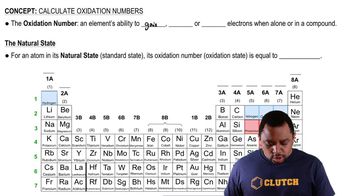Textbook Question
Assign oxidation numbers to each element in the following ions. (a) Cr(OH)4-
630
views
 Verified step by step guidance
Verified step by step guidance



Assign oxidation numbers to each element in the following ions. (a) Cr(OH)4-
Assign oxidation numbers to each element in the following ions. (b) S2O3 2-
Assign oxidation numbers to each element in the following ions. (c) NO3-
Assign oxidation numbers to each element in the following ions. (e) HPO4 2-
Assign oxidation numbers to each element in the following ions. (f) V2O7 4-
Nitrogen can have several different oxidation numbers ranging in value from -3 to +5. (a) Write the formula and give the name of the nitrogen oxide compound in which nitrogen has an oxidation number of +1, +2, +4, and +5.